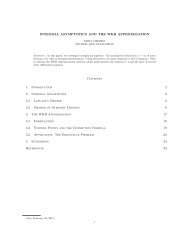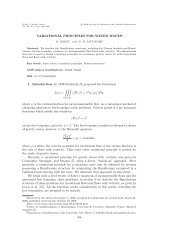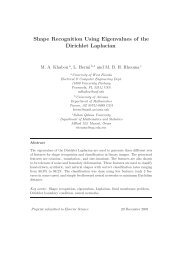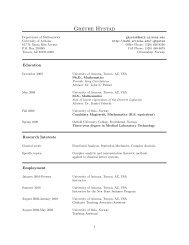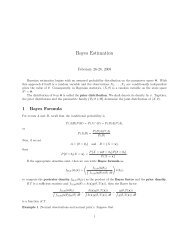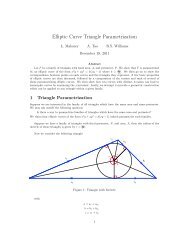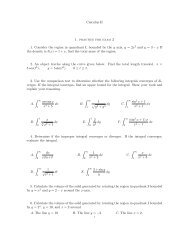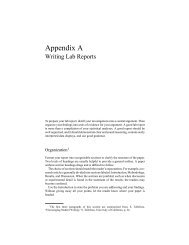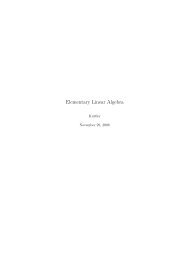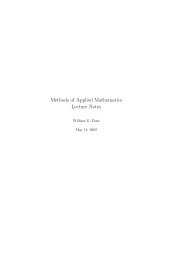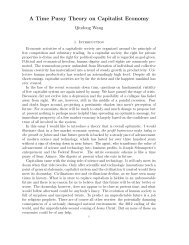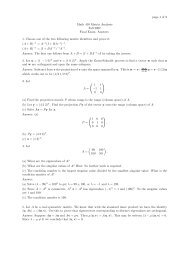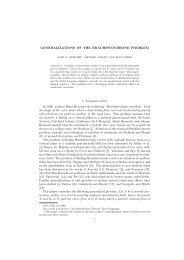Math 215 Project 2: Balancing Chemical Equations
Math 215 Project 2: Balancing Chemical Equations
Math 215 Project 2: Balancing Chemical Equations
You also want an ePaper? Increase the reach of your titles
YUMPU automatically turns print PDFs into web optimized ePapers that Google loves.
<strong>Math</strong> <strong>215</strong> <strong>Project</strong> 2: <strong>Balancing</strong> <strong>Chemical</strong> <strong>Equations</strong><br />
Written by: Rebecca Strautman<br />
Problem Description: <strong>Chemical</strong> equations are written with the reactants (the chemicals you start with) on<br />
the left, and the products (the chemicals you end with) on the right. By the Law of Conservation of Mass, the<br />
number of atoms must be the same on both sides (for instance, if you have 2 atoms of carbon on the left, you must<br />
have 2 atoms of carbon on the right) because these atoms cannot be created or destroyed in a reaction. <strong>Balancing</strong><br />
an equation means guring out how much of each reactant you need to make how much of each product. For<br />
example, to balance the equation:<br />
H 2 + O 2 → H 2 O<br />
We simply do the following:<br />
2H 2 + O 2 → 2H 2 O<br />
Now we have 4 atoms of H on each side, and 2 of O, so it is balanced. For many problems, you can probably gure<br />
the constants out in your head, but if there are many elements involved, we can instead use linear algebra.<br />
Example Problem: Consider the unbalanced reaction<br />
C 2 H 6 + O 2 → CO 2 + H 2 O.<br />
Assign each molecule a variable x 1 , . . . , x 4 since we have 4 expressions in the reaction.<br />
x 1 C 2 H 6 + x 2 O 2 → x 3 CO 2 + x 4 H 2 O.<br />
Now, we write out the requirements for each element<br />
C : 2x 1 = x 3<br />
H : 6x 1 = 2x 4<br />
O : 2x 2 = 2x 3 + x 4 .<br />
Bringing everything to the left hand side, we have a system of linear equations which we can write in the form<br />
2x 1 − x 3 = 0<br />
6x 1 − 2x 4 = 0<br />
2x 2 − 2x 3 − x 4 = 0.<br />
We put these into an augmented matrix and get<br />
⎡<br />
2 0 −1 0<br />
⎤<br />
0<br />
⎣ 6 0 0 −2 0 ⎦ .<br />
0 2 −2 −1 0<br />
The reduced row echelon form of this matrix is<br />
⎡<br />
1 0 −1 −1/3<br />
⎤<br />
0<br />
⎣ 0 1 0 −7/6 0 ⎦ .<br />
0 0 1 −2/3 0<br />
1
This gives the solution set<br />
⎡<br />
x =<br />
⎢<br />
⎣<br />
1<br />
3<br />
7<br />
6<br />
2<br />
3<br />
1<br />
⎤<br />
t.<br />
⎥<br />
⎦<br />
We need to choose t such that the vector x contains only integers, and so the components of x do not have any<br />
common factors (we want the equation to be in its reduced form). In this solution set, we can take t = 6. So our<br />
balanced chemical equation is<br />
2C 2 H 6 + 7O 2 → 4CO 2 + 6H 2 O.<br />
Assigned Problem: Use the method described above to balance each of the following chemical equations:<br />
(a) K 4 F e (CN) 6<br />
+ H 2 SO 4 + H 2 O = K 2 SO 4 + F eSO 4 + (NH 4 ) 2<br />
SO 4 + CO<br />
(b) P hCH 3 + KMnO 4 + H 2 SO 4 = P hCOOH + K 2 SO 4 + MnSO 4 + H 2 O.<br />
A few helpful hints: Subscripts on an atom denote the number of atoms of that element in one molecule of the<br />
reactant or product. If multiple atoms are in parentheses with a subscript (NO 3 ) 2<br />
, this subscript distributes and<br />
you have 2 atoms of nitrogen (N) and 6 of oxygen (O). Finally, for those who are unfamiliar with chemistry,<br />
abbreviations for elements consist of either a capital letter (O, N, C...) or a capital letter followed by a lowercase<br />
one (Na, Cl, Ag...), so KCl consists of two elements, denoted by K and Cl.<br />
2



